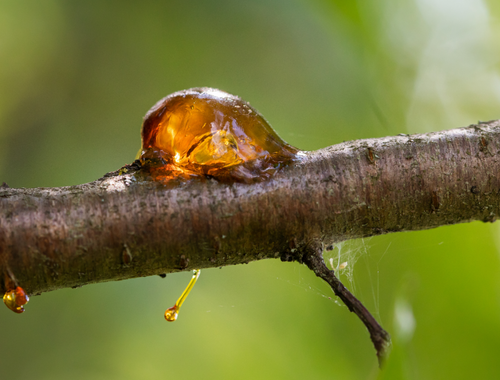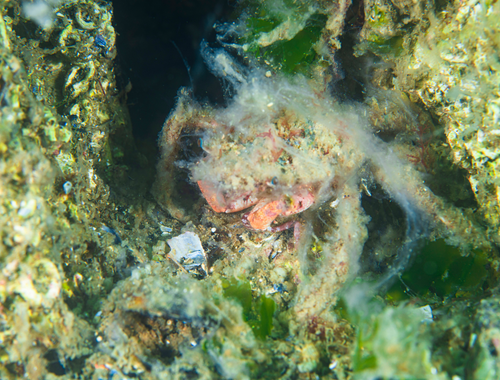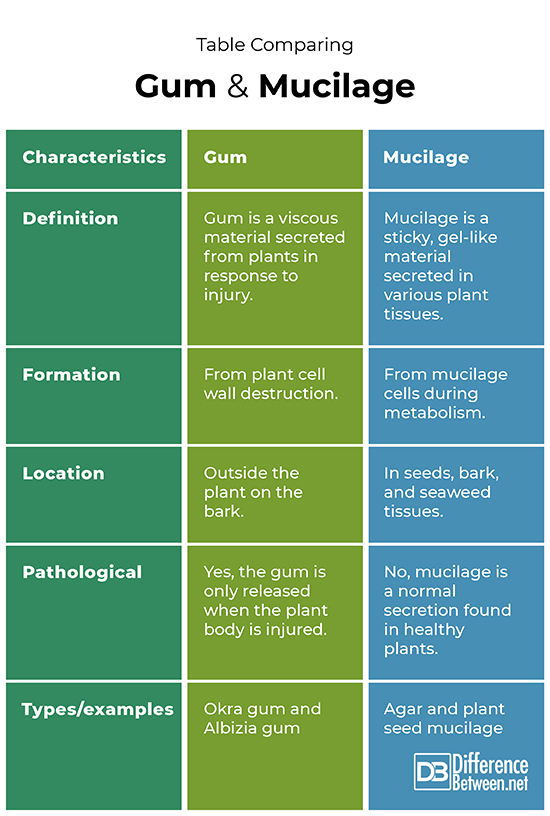Difference Between Gum and Mucilage
Gums are thick plant secretions that do readily dissolve in water and are made when a plant is injured. Mucilage is a sticky and gel-like substance that is normally made inside plant cells.

What is Gum?
Definition:
Gum is a plant secretion that is viscous but can dissolve in water and is produced when there is an injury.
Formation:
Gummosis is the name for how gum is formed. Trees produce gum when there is some type of trauma to the plant. This triggers the cell walls to break down to make the gum, which is then secreted.
Properties:
Plant gums are polysaccharides that occur in chains. A polysaccharide is made up of several monosaccharides (simple sugars) combined to form these complex carbohydrates known as monosaccharides. The gum is usually a tan color, and commonly contains a lot of galactose sugars in the carbohydrate molecule.
Types/examples of gum:
Okra gum is one type that is secreted by the plant Abelmoschus esculentus; this gum containsseveral sugars, which are mainly galactose, galacturonic acid, and rhamnose. Albizia zygia, which produces Albizia gum, is another type; it contains several galactose units that are linked together in a specific way.
Application:
Cosmetic companies use gums to manufacture their products. Gums are also often used in pharmaceutical companies to help when making medications. For instance, Abelmoschus esculentus gum aids the gastric floating properties of medicines, which is important in determining how medication reacts in the stomach. This impacts when the dose is released and even if the medicine needs to be transported further along the digestive tract before being absorbed.

What is Mucilage?
Definition:
Mucilage is a gel-like, sticky, and slimy substance that is found in different plant tissues.
Formation:
Plant mucilages are made in the plant cells during metabolism. Mucilage is a chemical that is specifically produced from mucilage cells during a series of chemical reactions.
Properties:
Mucilage is made up of carbohydrates and a substance, which is known as uranic acid. Mucilage is a substance that has adhesive properties and is slimy.
Types/examples of mucilage:
Plant seed mucilage, for instance, that of linseed, Linium usitatitissimum, helps ensure water absorption by the seed and it helps control the rate of growth of the seed and new plant. Seaweeds also have a type of mucilage, and so does the bark of Slippery Elm. Fenugreek mucilage is made in the seeds of Trigonella foenum-graceum. Cocculus hirsute yields cocculus mucilage from the leaves.
Application:
The mucilage of Abelmoschus esculentus is used to make the suspension for paracetamol medication. The disintegration time of tablets is increased when Ocimum mucilage is used in the formulation; this can help speed up medication availability in the body.
Difference between Gum and Mucilage?
Definition
Gum is a viscous material secreted from plants in response to injury. Mucilage is a sticky, gel-like material secreted in various plant tissues.
Formation
Gum is made when plant cell walls are destroyed. Mucilage is made inside of special mucilage cells, which are found inside plants, and is secreted under normal conditions.
Location
Gum is found outside of the plant or just under the bark. Mucilage is found in various tissues such as, the leaves, bark and seed of plants, and in seaweed.
Pathological
The production of gum is pathological because it is only released if the plant has been injured. The production of mucilage is not pathological because it is released under normal conditions in a healthy plant.
Types/examples
Okra gum and Albizia gum are two types of plant gum. Plant seed mucilage and agar are two examples of mucilage.
Table comparing Gum and Mucilage

Summary of Gum Vs. Mucilage
- Gums and mucilages are both types of secretions from the plant body that are made up of mainly carbohydrate molecules.
- Plant gums are usually produced as a response to some damage done to the plant, and they usually occur on the bark or just under the bark of a tree.
- Plant mucilages are made and released in several tissues such as seeds, buds, leaves of plants, and in seaweeds.
FAQ
What are the main characteristics of gums and mucilages?
Gums are viscous secretions of carbohydrates found on the bark after an injury. Mucilages are sticky secretions found in seeds and other plant tissues.
What is mucilage with example?
Mucilage is a sticky secretion that is formed by plant cells. An example of mucilage is plant seed mucilage that is made in the linseed plant.
What are gums and mucilages chemically?
Chemically, both gums and mucilages are made of carbohydrates; mucilage also has uranic acid present in the molecule.
What is the function of mucilage?
The function of mucilage is the protection of the plant, assistance with water uptake, and control of growth.
What is mucilage and its function?
Mucilage is a chemical substance made in the seeds, leaves, and buds of plants. It helps the plant retain water, store food, and help with growth (when present in the seed endosperm).
Is agar a gum or mucilage?
Agar is a mucilage found in seaweeds like Fucus and Laminaria.
Are gums and mucilages carbohydrates?
Yes, both gums and mucilages are mainly made up of carbohydrate molecules.
What are gums in plants?
Gums are molecules made in plants that consist of carbohydrate chains and occur on or in the bark.
- Difference Between Rumination and Regurgitation - June 13, 2024
- Difference Between Pyelectasis and Hydronephrosis - June 4, 2024
- Difference Between Cellulitis and Erysipelas - June 1, 2024
Search DifferenceBetween.net :
Leave a Response
References :
[0]Cimiano, Philipp, and Johanna Völker. "Pharmaceutical applications of natural gums, mucilages and pectins – a review." International conference on application of natural language to information systems. Springer, Berlin, Heidelberg, 2005.
[1]Editors of Encyclopedia Britannica. “Gum”. Encyclopedia Britannica, 2022, https://www.britannica.com/technology/gum-adhesive
[2]Soukoulis, Christos, Claire Gaiani, and Lucien Hoffmann. "Plant seed mucilage as emerging biopolymer in food industry applications." Current Opinion in Food Science 22 (2018): 28-42.
